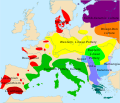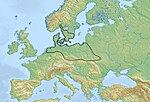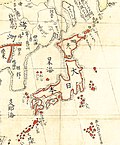 | Cord-marked pottery or Cordmarked pottery is an early form of a simple earthenware pottery. It allowed food to be stored and cooked over fire. Cord-marked... 10 KB (1,225 words) - 21:44, 4 April 2024 |
The excavation yielded typical shouldered celts and cord-marked pottery. The cord-marked pottery is a unique characteristic that this site shares with... 5 KB (625 words) - 11:53, 2 January 2024 |
 | with a large variability in dates ranging from 9000 BC to 5500 BC. Cord-marked pottery was discovered among the burial goods. Another important site is... 4 KB (356 words) - 06:06, 2 October 2022 |
 | to 1000 BCE), is characterized by red-slipped and fine cord-marked pottery similar to the pottery assemblages of prehistoric Taiwan. Phase 2 (1300 BCE to... 22 KB (2,230 words) - 17:13, 8 April 2024 |
 | was discovered in the Penghu Channel c. 2008. Finds of fine red cord-marked pottery at Guoye, Huxi, indicate that Penghu was visited by Austronesians... 62 KB (6,159 words) - 13:41, 21 April 2024 |
 | Jōmon period (section Pottery) complexity. The name "cord-marked" was first applied by the American zoologist and orientalist Edward S. Morse, who discovered sherds of pottery in 1877 and subsequently... 52 KB (5,853 words) - 21:07, 22 April 2024 |
 | Pre-Pottery Neolithic A (PPNA) denotes the first stage of the Pre-Pottery Neolithic, in early Levantine and Anatolian Neolithic culture, dating to c. 12... 15 KB (1,545 words) - 04:08, 20 June 2023 |
 | Bell Beaker culture (redirect from Beaker pottery) the use of the Beaker pottery on the Balearic Islands, between about 2475 and 1300 BC. Some evidence exists of all-corded pottery in Mallorca, generally... 162 KB (19,036 words) - 22:21, 12 April 2024 |
 | The Pre-Pottery Neolithic (PPN) represents the early Neolithic in the Levantine and upper Mesopotamian region of the Fertile Crescent, dating to c. 12... 18 KB (1,838 words) - 12:21, 20 April 2024 |
 | include beads made of imported turquoise, cord-marked pottery, imported San Lazaro Glaze Polychrome pottery made during the Ancient Pueblo People Pueblo... 6 KB (654 words) - 22:08, 21 April 2024 |
 | Pre-Pottery Neolithic B (PPNB) is part of the Pre-Pottery Neolithic, a Neolithic culture centered in upper Mesopotamia and the Levant, dating to c. 10... 21 KB (2,152 words) - 23:29, 26 March 2024 |
people towards Kansas. Pottery was used for cooking and storage and some of it was decorated. More notable was cord marked pottery that was another influence... 4 KB (514 words) - 15:16, 31 January 2024 |
 | Neolithic (redirect from Pottery Neolithic Age) millennium BC. Early development occurred in the Levant (e.g. Pre-Pottery Neolithic A and Pre-Pottery Neolithic B) and from there spread eastwards and westwards... 79 KB (8,089 words) - 11:43, 21 April 2024 |
 | Iznik pottery, or Iznik ware, named after the town of İznik in Anatolia where it was made, is a decorated ceramic that was produced from the last quarter... 54 KB (6,905 words) - 08:24, 12 April 2024 |
 | examples found at the cave were not cord-marked pottery, but decorated with appliqué of dots or strips of clay. Pottery examined by CT scan found fibers... 8 KB (909 words) - 11:00, 3 September 2023 |
hundred years ago. These consisted of stone tools, spear points, cord-marked pottery, and large cooking hearths. A historical marker was erected in 1947... 14 KB (1,526 words) - 06:31, 6 April 2024 |
 | culture's pottery and lithic technology were typical of Late Woodland peoples; earlier generations of the culture seemingly produced cord-marked pottery and... 4 KB (498 words) - 00:13, 14 July 2022 |
agricultural village complex, pottery is a newly defined pottery type now being called Page Plain along with a few sherds of Page Cord-marked ware in very limited... 122 KB (16,896 words) - 18:31, 12 November 2023 |
 | The Linear Pottery culture (LBK) is a major archaeological horizon of the European Neolithic period, flourishing c. 5500–4500 BC. Derived from the German... 76 KB (8,531 words) - 18:24, 22 March 2024 |
 | In the early 3rd millennium BCE, the Corded Ware culture appeared in Northern Europe. Its peoples were of marked steppe-related ancestry and traced their... 41 KB (4,567 words) - 20:22, 23 April 2024 |
Hồng Bàng dynasty (section Pottery) northern Viet Nam, the regional characters of the pottery are fairly marked. On the whole, Đông Sơn pottery has a high firing temperature and is varied in... 33 KB (3,585 words) - 19:53, 22 April 2024 |
 | Adena culture (section Pottery) limestone and was very thick; its decoration was largely plain, cord-marked or fabric marked, although one type bore a nested-diamond design incised into... 18 KB (1,404 words) - 23:07, 4 April 2024 |
 | Battle Axe culture (category Corded Ware culture) southwest Finland, from c. 2800 BC – c. 2300 BC. It was an offshoot of the Corded Ware culture, and replaced the Funnelbeaker culture in southern Scandinavia... 20 KB (2,464 words) - 15:31, 13 April 2024 |
 | Fort Ancient (redirect from Fort Ancient culture pottery) storage jar with cord-marked decorations and strap handles During the Early Fort Ancient period, grit (crushed stone) and grog (crushed pottery) were often... 47 KB (4,486 words) - 06:24, 28 March 2024 |






